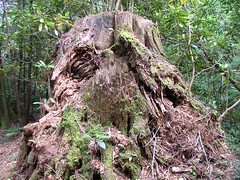For several nights the next 2 weeks I am taking part in a study by TVA about Bat Mortality associated with a windfarm north of Oak Ridge. This isn't the first study that has been done at this location, but it sounds quite interesting. The previous studies found that many more bats than birds were being killed, and the vast majority of these bat deaths occurred in late August and early September (during bat migration). Some of the things this is going to try to answer are (1) what is the time of these deaths (throughout the night, only at sunset/rise), (2) are the bats feeding when they hit or are they just flying (a portable radar is going to measure bat movements), and (3) do different turbines have different kill numbers (there are two different types of turbines there). For example, if the most of the kills were found to be at sunset/rise, then the turbines could just be stop for a couple hours a night for a few weeks and stop the vast majority of bat deaths.
My first night is tonight, so hopefully I will be able to post some cool pictures and more information in the future. Below is the picture I took in February from Frozen Head. Notice the small white things on the ridge line in the background.
Unforced variations: Jan 2026
1 day ago











